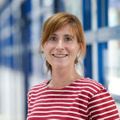Pluripotent stem cells to explore mechanisms and treatments of neuromuscular diseases
Disease-specific human pluripotent stem cells (hPSCs) represent a new chance to unravel cellular and molecular mechanisms of neurological diseases. Along this line, we were among the first to demonstrate that PGD-derived hES cells and derivatives offer pertinent cellular models of neuromuscular diseases. Indeed, we showed that PGD-derived hES cells and derivatives which express the causal mutation leading to the neuromuscular disorder Myotonic Dystrophy type 1 (DM1), can be used to model DM1-specific pathological features in vitro. Furthermore these models when combined to a whole genome transcriptomic analysis can unravel new physiopathological mechanisms. In parallel to these mechanistic analyses, we demonstrated that DM1 hESCs-based models can be used for therapeutic screenings leading to the recent launching of a clinical trial on DM1 patients.
Altogether, our DM1 studies participated to the demonstration that disease-specific hPSCs and their derivatives are effective models of neuromuscular diseases to decipher new pathological mechanisms and allow for drug discovery with potential clinical applications. Furthermore failures and successes in the DM1 program was instrumental in defining important roadblocks to overcome in order to successfully model neuromuscular pathologies using hPSCs : 1) the development of a collaborative environment to have access to other models of the pathology that will further validate the results obtained using hPSCs derived cells, 2) the careful analysis of appropriate controls (ideally isogenic ones) and 3) the development of differentiation protocols to obtain with high yield and robustness the cell population most relevant to the pathology of interest.
Our general objective is now to take advantage of this expertise to refine pathological modeling of neuromuscular disorders. Neuromuscular diseases are a heterologous group of pathologies characterized by muscular paralysis due to intrinsic muscular defects and/or impairment of neural circuits controlling movement often through to spinal motor neuron degeneration. In that sense Myotonic Dystrophy Type 1 and Spinal Muscular Atrophy, the two pathologies on which our group is focusing represent paradigmatic neuromuscular disorders. They are both caused by ubiquitously expressed mutations and characterized by defects in the motor neuron/muscle interconnection.
Research projects developed by my group, that is implanted in the institute ISTEM, is to better understand physiological mechanisms implicated in the development of neuromuscular diseases and subsequently to develop new therapeutic strategies. We have three main domains of research: i). improve the protocols of differentiation to convert efficiently and reliably cell types of interest, i.e. motoneurons and muscle cells; ii). To improve our knowledge on the communication between motoneurons and muscle cells by developing new cellular systems iii). apply these different tools to neuromuscular diseases with the aim to decipher physiopathological mechanisms and to identify new pharmacological strategies. My group is mainly interested in two neuromusuclar diseases: myotonic dystrophy type 1 and spinal muscular atrophy. I recently took the head of the INSERM Unit located in ISTEM, institute dedicated to the use of human pluripotent stem cells to develop new therapeutic strategies for monogenic diseases. Two main of applications are developed in ISTEM: cell therapy and drug screening. More recently, I have been elected president of the French Society for Stem Cell Research (FSSCR, www.fsscr.fr). The main objective of this society, launched in January 2017, is to underpin and federate short and long-term efforts to ensure the place of France as a leader in the domain of stem cell research.


